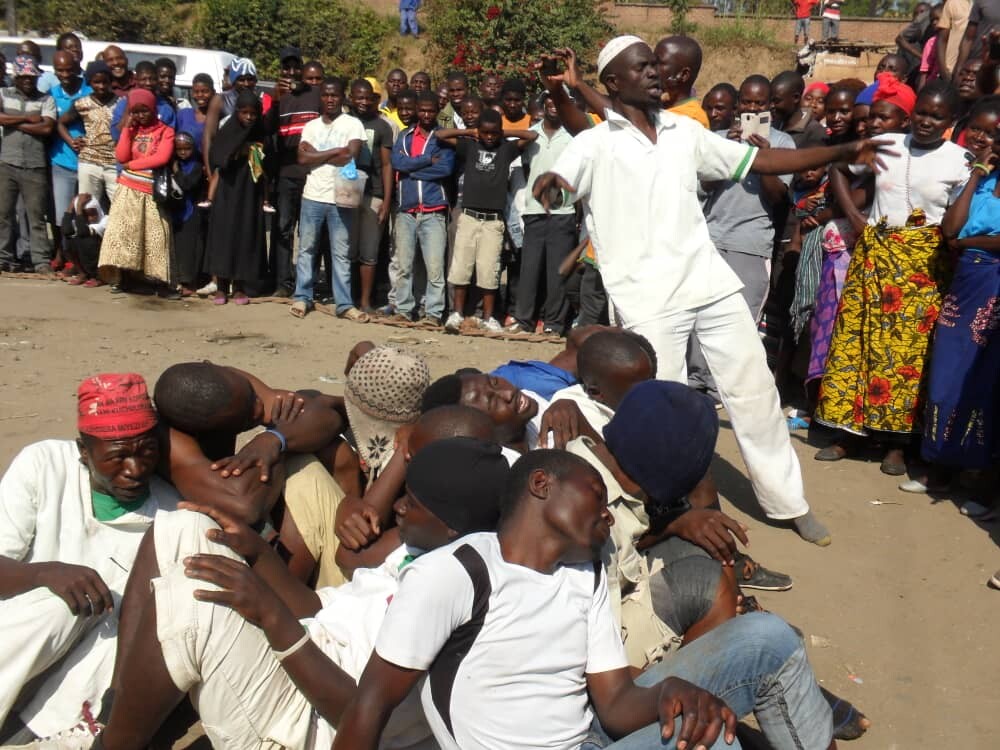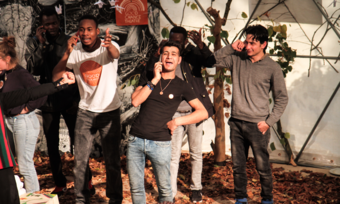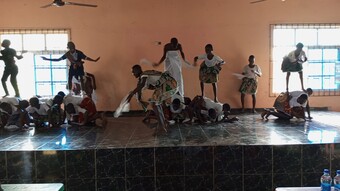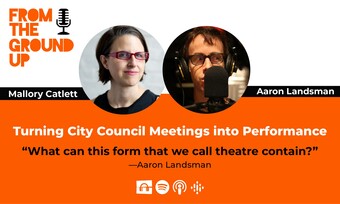The Beginning of the Form
Theatre for development had an interesting beginning in Malawi. According to an academic article written by Dr. Mufunanji Magalasi, a lecturer and theatre practitioner at the University of Malawi, theatre for development—or “popular theatre,” as it used to be known—dates back to July 1981. The office of the president (then under the oppressive one-party regime of Dr. Kamuzu Banda) had invited the Chancellor College Travelling Theatre, led by the late Chris Kamlongela, an associate professor in the English department, to perform at the opening of the newly established Mbalachanda Rural Development Center.
“The thinking of the government was that the travelling theatre could provide a forum of entertainment, of cultural exchange, of education, and of a team spirit among the extension workers and also the local people,” Magalasi writes, quoting Kamlongela.
Chancellor College Travelling Theatre arrived in Mbalachanda, in the Northern Region of Malawi, having created vernacular plays about health, adult literacy, and agriculture with help of Kamlongela and Professor David Kerr, another member of the English Department at Chancellor College. (According to Magalasi, Professor Kerr had previously worked a lot in Zambia, taking groups of experienced drama students to rural areas and training local secondary school students and teachers to create plays in local languages through improvisation. Kerr then brought that experience to Malawi.)
On top of fulfilling the obligation set by the government, Chancellor College Travelling Theatre decided to spend eight more days in the area to conduct workshops with a group of local participants. From those workshops two plays were devised and performed. The first one was titled Kufunika Kwa Ukhondo (The Need for Cleanliness) and the second one was titled Kumanya Mbwananga (Knowledge Is Freedom), which tackled the reluctance of the locals to attend adult literacy sessions—an issue that was identified by the research conducted by Chancellor College. It is from these humble roots in an oppressive regime that theatre for development started to sprout in Malawi.
By 1987, they had begun to incorporate cultural forms into the structure of the play, including traditional oral storytelling, folk songs, and dance.
A Growing Field
Analyzing the Mbalachanda theatre for development performances, Magalasi noted that the form’s framing of using a “community approach” was problematic. For starters, participation throughout the performance was limited to rhetorical questions; no dialogue was actually being had with the community. He also adds that the content of the plays did not always reflect the true needs or the perspectives of the community. But, after the performance in Mbalachanda, the field began growing and has continued to diversify to keep up with issues of the day.
In 1985, the public health communications unit in Liwonde requested a performance from Chancellor College Travelling Theatre. The area was said to have high rate of malaria and diarrhea. This time, the theatre group started with a community diagnosis before going to their base to discuss their findings. From those discussions, a play titled Chitsime (The Well) was created. It tackled issues related with the wells—where they were placed in the village and how that affected the way people used them, which led to the health problems. Techniques used in the performance included arguments between characters and character dilemmas, which led to audience participation in the form of “open ups,” a technique of directly addressing the audience and asking them for solutions to the problem at hand. In Magalasi’s article, he says that, at the end of the show, the group of actors adopted Augusto Boal’s approach of telling the audience to remake the play to change the consequences of bad behavior by acting out the good behavior.
Later, there was a feeling among theatre for development practitioners at Chancellor College that the Liwonde performances had not incorporated Indigenous forms of art, and the group decided this was important. By 1987, they had begun to incorporate cultural forms into the structure of the play, including traditional oral storytelling, folk songs, and dance.
Since then, theatre for development productions have taken different variations, the most popular being the use of comedy duos like Izeki and Jakobo to deliver messages while entertaining people. This is mostly a one-way approach, where audiences just watch and absorb the knowledge being shared from the actors. Though not systematic theatre for development (as defined by Boal and other scholars), the comedians fulfill a duty of educating the nation on various issues. The most systematic approaches, however, are being advanced by organizations like Creative Centre for Community Mobilization (CRECOM), the Story Workshop, Theatre for a Change, Youth Net and Counselling (YONECO), and Dikamawoko Arts. These places have harnessed the power of the theory and practice of theatre for development in its full sense.
For example, according to Theatre for Change’s website, they owe a lot to Augusto Boal’s forum theatre techniques and the educational theories of Paulo Freire and Robert Chamber’s insights into learning and action. They begin their performances, though, with traditional dances to introduce the play and mobilize the people, before switching to an approach to theatre for development called interactive theatre. Their website reads: “With interactive theatre, marginalized groups can tell their own stories, in their own words, to people of their community—including power-holders who they would never normally meet, let alone talk to.”
Using a method called touch tag, Theatre for a Change’s participants invite the audience into the play, where they become the character they want to help and experiment with different ways of confronting the challenges the character is facing and find a better ending to their story. When interactive theatre is focused on legal issues, it is called legislative theatre; one example is when female sex workers marched in the streets of Lilongwe (the capital of Malawi) to parliament, where they gave a legislative theatre performance in front of the police and parliamentarians.
The majority of theatre for development is dependent on donor funding—and if the funding stops, the industry dies.
The Process
Kabvina’s theatre for development work at the Story Workshop starts with planning and research, which provides information for the creation of a storyline and the development of scenes. “From there, it moves to costumes and props, preparation of performance location, logistics, checking characters, and message consistency,” he says. “Our performance consists of mimes and improvisations, music and dance, and many other techniques to help get the message across.”
Fumbani Innot Phiri, founder of Young Collaborators for Development, one of the most proficient theatre groups in Malawi, says his first experience with theatre for development “involved very critical topics like safe abortions, social empowerment, and LGBTQ rights.” This shows how theatre for development has matured in Malawi from the Mbalachanda days of tackling acceptable topics like hygiene and illiteracy, to the modern days when it can be bold enough to stand up for the rights of women to access safe abortions and the rights of the LGBTQ community—things that are illegal as far as the Malawi constitution is concerned.
“Our process involved researching and gathering case studies, then we would sit down to discuss and create improvised scenes and later perform them to an audience,” Phiri says.
Bright ChayaChaya, who studied communications and cultural studies at the University of Malawi and is now the theatre for development coordinator for YONECO, takes me through their process, which is not so different from the one detailed by Phiri. It includes elements from Boal and some from the early Chancellor College Travelling Theatre experiments, like research, story devising, performance, and audience interaction.
In my conversations with both Phiri and ChayaChaya, two things became clear. The first is that all of their theatre for development work is dependent on donor funding or is a component of bigger projects from international organizations (for example, UN Women could hire a theatre company to create a performance during a function). The second is that the basics are the same: the form is built on Boal’s forum theatre techniques and some productions are fused with cultural elements like traditional music.













Comments
The article is just the start of the conversation—we want to know what you think about this subject, too! HowlRound is a space for knowledge-sharing, and we welcome spirited, thoughtful, and on-topic dialogue. Find our full comments policy here